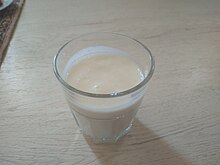| Laban rayeb | |
|---|---|
 | |
| Country of origin | Egypt |
| Region | Nile Delta, Lower Egypt |
| Pasteurised | No |
| Texture | Liquid |
Laban rayeb is a type of curdled skim and fermented milk made in Lower Egypt. It may be drunk fresh or may be used to make areesh cheese, which in turn is used to make mish. There is evidence that it was made by the ancient Egyptians.
Preparation
The traditional way to make laban rayeb starts with milking cows directly into partially sterilized shallow or deep earthenware pots. The inside of a newly made pot (matared) is soaked in oil or a mixture of egg white and oil and then baked in a kiln to close the pores. After each use the matared is washed and dried in a hot oven for two hours. The milk is left for one to four days, depending on the temperature, while the fat rises to the top and the milk below curdles. The milk is kept at 20–25 °C (68–77 °F) while the curd forms. The milk is not disturbed while its natural microflora ferment it. The fat is scooped out and used to make butter. The remaining curd is the laban rayab. It smells similar to buttermilk, and has a slightly acid taste.
Variants and derived products
Laban khad is a variant that is fermented in a goat pelt. Goubasha is a traditional drink in the Sudan. Some cream is added to laban rayeb made from buffalo milk, and the mixture is then diluted with water. Laban zeer is another variant made in earthenware pots. It may be mixed with boiled, dried and ground wheat grains, fermented for twenty four hours, then sundried to make Kishk. This is a very nutritious food that may keep for several years.
Karish cheese is made from laban rayeb by pouring the curd onto a reed mat and letting it drain, occasionally spreading it and squeezing it in the mat, and then hanging it for two or three days. Shortly before being finished the cheese is dry-salted, and then hung in the mat for a few more hours.
References
Citations
- ^ Robinson & Tamime 1991, p. 181.
- Kurmann, Rasic & Kroger 1992, p. 185.
- ^ Chandan & Kilara 2013, p. 16.
- Kurmann, Rasic & Kroger 1992, p. 184.
- Kurmann, Rasic & Kroger 1992, p. 137.
- Marth & Steele 2001, p. 321.
- Robinson & Tamime 1991, p. 183.
Sources
- Chandan, Ramesh C.; Kilara, Arun (2013-01-08). Manufacturing Yogurt and Fermented Milks. John Wiley & Sons. ISBN 978-1-118-48133-2. Retrieved 2013-04-15.
- Kurmann, Joseph A.; Rasic, Jeremija L.; Kroger, Manfred (1992-10-31). Encyclopedia of Fermented Fresh Milk Products: An International Inventory of Fermented Milk, Cream, Buttermilk, Whey, and Related Products. Springer. p. 137. ISBN 978-0-442-00869-7. Retrieved 2013-04-15.
- Marth, Elmer H.; Steele, James (2001-05-22). Applied Dairy Microbiology, Second Edition. CRC Press. ISBN 978-1-4200-0236-2. Retrieved 2013-04-15.
- Robinson, R. K.; Tamime, Adnan Y. (1991-06-01). Feta and Related Cheeses. Woodhead Publishing. p. 181. ISBN 978-1-85573-278-0. Retrieved 2013-04-15.